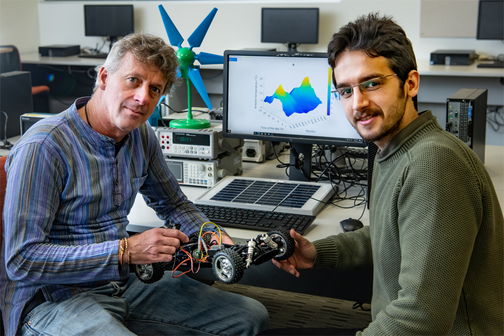Chair in Sustainable Energy Systems

The Chair supports the transition to sustainable energy of the New Zealand and regional economy, and society.
About the Chair
The Chair was established in July 2017. It is aligned with the strategic
sustainability focus at Victoria University of Wellington, to meet current and future challenges, by taking an inter-disciplinary approach, and engaging with partners across society in trans-disciplinary ways.
Principles
The Chair is founded on the Māori principles of:
- Kaitiakitanga—conservation and protection, or sustainable;
- Mauri—core essence and life force, or energy;
- Whakapapa—relationships and connections, or systems.
The blue triangle of the Chair’s integrated symbol depicts our ocean, fresh water, and wind energy resources, and maintaining the sustainability of our natural environment, the economy, and our society. The yellow circle refers to our solar resource, and porowhita; our never-ending journey of discovery and re-discovery. The green spiral emphasises our land resources, and koru; growth and the loop of utilising renewable resources. | |
 |
People
Academic Staff
PhD Students
Education
Two options are offered to study
renewable energy at undergraduate level.
For Māori, Pasifika and women school leavers that intend to enrol for the major in Electrical and Electronic Engineering with a specialisation in Renewable Energy Systems Engineering a
scholarship is available.
Several options are also offered to study
renewable energy at postgraduate level.

Research
Current research topics and future research directions can be found here:
Sustainable Energy Systems research areas
Research group publications listed by year:
SES publications
Current research focus area:
Agrivoltaics
Research products and tools:
SMOULDER
Global open-source energy system modelling initiative:
PyPSA meets Earth
 Decarbonise, decentralise and digitalise
Storing energy for a transitioning grid
How AI can help the move to a low-carbon future
How ‘smart integrated renewable energy systems’ can drive sustainable economic development in remote communities
The future of energy after Covid-19
Where are we at with solar energy?
Can game theory give a more realistic understanding of transactive energy and demand response efforts?
The problem with switching to EVs
Small power: Scaling down hydrogen to our communities
Electrifying transport: Why New Zealand can’t rely on battery-powered cars alone
Vehicle-to-Grid demand response can lead the way for decarbonizing city fleets
Our changing world - Keeping the lights on
Helping remote communities using AI
Artificial intelligence designs power network for remote Rakiura Stewart Island
Going off-grid with micro-grids
Harnessing the full potential of flexible loads to improve the economics of 100%-renewable isolated microgrids
Locking in our high-priced dependence on metals for clean energy
Small communities could be buying, selling and saving money on electric power right now – here’s how
NZ’s proposed pumped storage hydropower project will cost billions – here’s how to make it worthwhile
The role of green hydrogen in driving the deployment of integrated sustainable energy systems
Cyclone Gabrielle: how microgrids could help keep the power on during extreme weather events
How AI could revolutionize agrivoltaics deployment
Driving a greener future: how your electric car could help power your neighbourhood
Blockchain integration in renewable energy and storage technologies: An exploration of environmental stewardship and resilient accountability
Solar farms can eat up farmland – but ‘agrivoltaics’ could mean the best of both worlds for NZ farmers
NZ energy crisis: electricity demand will jump as NZ decarbonises – can renewable generation keep up?
If NZ wants to decarbonise energy, we need to know which renewables deliver the best payback
Decarbonise, decentralise and digitalise
Storing energy for a transitioning grid
How AI can help the move to a low-carbon future
How ‘smart integrated renewable energy systems’ can drive sustainable economic development in remote communities
The future of energy after Covid-19
Where are we at with solar energy?
Can game theory give a more realistic understanding of transactive energy and demand response efforts?
The problem with switching to EVs
Small power: Scaling down hydrogen to our communities
Electrifying transport: Why New Zealand can’t rely on battery-powered cars alone
Vehicle-to-Grid demand response can lead the way for decarbonizing city fleets
Our changing world - Keeping the lights on
Helping remote communities using AI
Artificial intelligence designs power network for remote Rakiura Stewart Island
Going off-grid with micro-grids
Harnessing the full potential of flexible loads to improve the economics of 100%-renewable isolated microgrids
Locking in our high-priced dependence on metals for clean energy
Small communities could be buying, selling and saving money on electric power right now – here’s how
NZ’s proposed pumped storage hydropower project will cost billions – here’s how to make it worthwhile
The role of green hydrogen in driving the deployment of integrated sustainable energy systems
Cyclone Gabrielle: how microgrids could help keep the power on during extreme weather events
How AI could revolutionize agrivoltaics deployment
Driving a greener future: how your electric car could help power your neighbourhood
Blockchain integration in renewable energy and storage technologies: An exploration of environmental stewardship and resilient accountability
Solar farms can eat up farmland – but ‘agrivoltaics’ could mean the best of both worlds for NZ farmers
NZ energy crisis: electricity demand will jump as NZ decarbonises – can renewable generation keep up?
If NZ wants to decarbonise energy, we need to know which renewables deliver the best payback
Awards

Best conference paper of IEEE PES-GM 2020
The paper titled ‘A Game-Theoretic Approach to Model Interruptible Loads: Application to Micro-Grid Planning’, by Soheil Mohseni, Professor Alan Brent, Dr Daniel Burmester, and Professor Will Browne was selected as one of the Best Conference Papers at the 2020 IEEE Power and Energy Society General Meeting (PES-GM). IEEE PES-GM is the flagship conference for the IEEE Power and Energy Society. Papers submitted for acceptance for presentation at the annual General Meeting number around 1,600 every year. Technical committees review these with an acceptance rate of around 40% that are then presented in one of different sessions at the General Meeting. The best paper review involved selecting 66 papers out of 644 accepted conference papers in 2020.
“As integrated community energy systems grow in New Zealand towards realising energy democracy, scientists and engineers need new frameworks to quantify the effect size of procuring small-scale demand response products on the cost-effectiveness of community-owned sustainable energy systems,” said Soheil, a PhD Candidate in Engineering, and Sustainable Energy Systems. “Researchers often make several simplifying assumptions on the actual dispatchability of smaller demand-side management resources. These assumptions disconnect the associated demand response flexibility management methods from reality and make it difficult to see how they can be applied to real-world community demand response schemes. A game-theoretic approach to the projection of behavioural demand response products that are bundled and controlled by specific providers (with an opt-out option) is necessary to give a more realistic grounding to the projection of aggregator-mediated interruptible demand response flexibility resources during the investment planning phases of community renewable energy systems.”
Specifically, the researchers have used the classic tit-for-tat strategy to characterise the interactions between utilities, demand response aggregators, and end-consumers. This provides an efficient, scalable, and accurate platform to account for the individualised customer discomfort tolerances, as well as the minimum profit margins required by third-party aggregators. With this framework, the model-inherent epistemic dimensions of demand response supply uncertainty could be treated implicitly.
To validate its utility and effectiveness when nested within the optimal asset allocation problem of community micro-grids, the researchers compared their game-theoretic demand-side flexibility management approach with a non-game-theoretic counterpart, as well as a case where no demand response programme was implemented. The numerical simulations were undertaken on a hydrogen-based test-case micro-grid specifically conceptualised for the town of Ohakune, New Zealand. Crucially, it was found that using the proposed game-theoretic demand response provision scheme achieves cost-savings of 13% (equating to NZ$1.4m) and 19% (equating to NZ$2.3m) over the proposed micro-grid’s lifetime compared with the non-game-theoretic modelling of aggregator-activated demand response resources and not running any demand response programmes, respectively. “We hope that researchers, engineers, developers, policy-makers, and the wider modelling community will find our game-theoretic demand response procurement approach useful not only for projecting demand-side flexibility resources but also for de-risking community-scale renewable energy projects – by providing a robust responsive demand hedge against the non-dispatchability of 100%-renewable energy systems involving a diverse mix of sustainable resources,” said Soheil.
The paper was presented by Soheil at the Best Conference Session on Distributed Energy Resources, Inverter-based Devices, and Microgrids. Additionally, it was presented in a poster format and won a Graduate Student Poster Contest Award (Second Prize). “I am delighted to accept this award from the IEEE Power & Energy Society,” Soheil said. “Our work at the research group Sustainable Energy Systems is developing an innovative new way to unlock the real potential of small- to medium-scale incentive-responsive loads that is aware of the endogenous social and behavioural factors underpinning the customer-supplied demand response capacity. The proposed framework can be implemented with advanced control and communications technologies and has the potential to provide significant system-level value for community energy schemes (in terms of energy security, energy equity, and environmental sustainability) in the future highly renewable smart grid milieu – towards resolving the energy trilemma.”
Related publications








